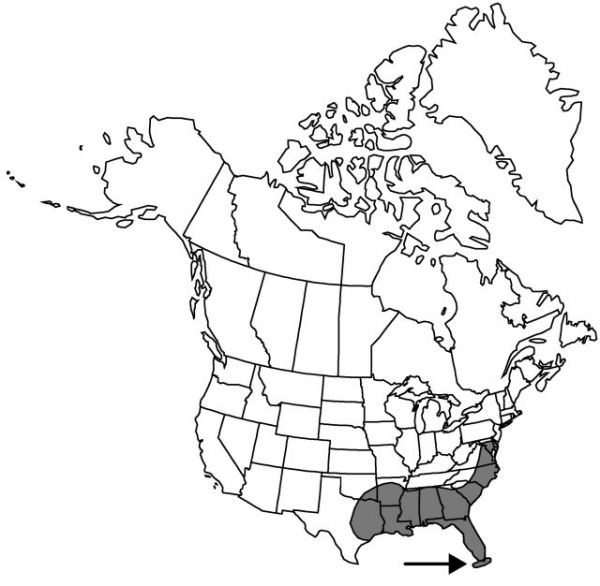Difference between revisions of "Smilax smallii"
Bull. Torrey Bot. Club 21: 430. 1894.
FNA>Volume Importer |
imported>Volume Importer |
||
| (4 intermediate revisions by 2 users not shown) | |||
| Line 8: | Line 8: | ||
}} | }} | ||
|common_names=Cantaque | |common_names=Cantaque | ||
| + | |special_status={{Treatment/ID/Special_status | ||
| + | |code=W1 | ||
| + | |label= | ||
| + | }}{{Treatment/ID/Special_status | ||
| + | |code=E | ||
| + | |label=Endemic | ||
| + | }} | ||
|basionyms={{Treatment/ID/Basionym | |basionyms={{Treatment/ID/Basionym | ||
|name=Smilax ovata | |name=Smilax ovata | ||
|authority=Pursh | |authority=Pursh | ||
| + | |rank=species | ||
|publication_title= | |publication_title= | ||
|publication_place=1814 | |publication_place=1814 | ||
| Line 17: | Line 25: | ||
|name=Smilax cinnamomiifolia | |name=Smilax cinnamomiifolia | ||
|authority=Small | |authority=Small | ||
| + | |rank=species | ||
}} | }} | ||
|hierarchy=Smilacaceae;Smilax;Smilax smallii | |hierarchy=Smilacaceae;Smilax;Smilax smallii | ||
| Line 41: | Line 50: | ||
-->{{#Taxon: | -->{{#Taxon: | ||
name=Smilax smallii | name=Smilax smallii | ||
| − | |||
|authority=Morong | |authority=Morong | ||
|rank=species | |rank=species | ||
| Line 55: | Line 63: | ||
|publication title=Bull. Torrey Bot. Club | |publication title=Bull. Torrey Bot. Club | ||
|publication year=1894 | |publication year=1894 | ||
| − | |special status= | + | |special status=W1;Endemic |
| − | |source xml=https:// | + | |source xml=https://bitbucket.org/aafc-mbb/fna-data-curation/src/2e0870ddd59836b60bcf96646a41e87ea5a5943a/coarse_grained_fna_xml/V26/V26_997.xml |
|genus=Smilax | |genus=Smilax | ||
|species=Smilax smallii | |species=Smilax smallii | ||
Latest revision as of 21:18, 5 November 2020
Vines; rhizomes irregularly tuberous, branched, thick, to 1.5+ m. Stems perennial, climbing, greenish or reddish brown, terete, 10+ m × 27 mm, woody, glabrous, glaucous when young; prickles few, scattered, recurved, flattened, 3–4 mm. Leaves evergreen, distally disposed (± evenly disposed on immature plants); petiole 0.3–1.3 cm; blade deep green, often variegated, drying to pale green, lanceolate-elliptic to narrowly ovate, prominently reticulate, 5-veined from base, 5–6.6 × 1.7–3 cm, abaxially glabrous, not glaucous, base rounded to cuneate, margins entire to undulate, apex acuminate. Umbels many, axillary to leaves, 7–15-flowered, loose to dense, hemispherical to spherical; peduncle 0.5–2.3 cm. Flowers: perianth green; tepals 3–6 mm; anthers ± 1/5 as long as filaments; ovule 1 per locule; pedicel (0.3–)0.5–0.7(–1) cm. Berries black, globose to compressed, 5.5–8 mm, glaucous.
Phenology: Flowering Jun–Jul.
Habitat: Rich woods, pinewoods, streambanks, edges of fields, swamp margins, ditches, well-drained but not dry soils
Elevation: 0–600 m
Distribution

Ala., Ark., Del., D.C., Fla., Ga., La., Md., Miss., N.C., Okla., S.C., Tex., Va.
Discussion
Smilax smallii is the highest-climbing species of Smilax within the flora and it is particularly conspicuous during the winter. It has been used as an ornamental and as a winter decoration, primarily in the Christmas trade. The starchy rhizomes and succulent, immature stems were used for food by Native Americans and early settlers.
Selected References
None.